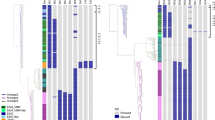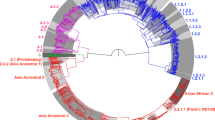Abstract
Mycobacterium tuberculosis remains a leading cause of death worldwide, especially among individuals infected with HIV1. Whereas phylogenetic analysis has revealed M. tuberculosis spread throughout history2,3,4,5 and in local outbreaks6,7,8, much less is understood about its dissemination within the body. Here we report genomic analysis of 2,693 samples collected post mortem from lung and extrapulmonary biopsies of 44 subjects in KwaZulu-Natal, South Africa, who received minimal antitubercular treatment and most of whom were HIV seropositive. We found that purifying selection occurred within individual patients, without the need for patient-to-patient transmission. Despite negative selection, mycobacteria diversified within individuals to form sublineages that co-existed for years. These sublineages, as well as distinct strains from mixed infections, were differentially distributed throughout the lung, suggesting temporary barriers to pathogen migration. As a consequence, samples taken from the upper airway often captured only a fraction of the population diversity, challenging current methods of outbreak tracing and resistance diagnostics. Phylogenetic analysis indicated that dissemination from the lungs to extrapulmonary sites was as frequent as between lung sites, supporting the idea of similar migration routes within and between organs, at least in subjects with HIV. Genomic diversity therefore provides a record of pathogen diversification and repeated dissemination across the body.
This is a preview of subscription content, access via your institution
Access options
Subscribe to this journal
Receive 12 print issues and online access
$209.00 per year
only $17.42 per issue
Buy this article
- Purchase on Springer Link
- Instant access to full article PDF
Prices may be subject to local taxes which are calculated during checkout




Similar content being viewed by others
Accession codes
References
World Health Organization. Global tuberculosis report 2015 1–204 (World Health Organization, Geneva, Switzerland, 2015).
Cohen, K.A. et al. Evolution of extensively drug-resistant tuberculosis over four decades: whole-genome sequencing and dating analysis of Mycobacterium tuberculosis isolates from KwaZulu-Natal. PLoS Med. 12, e1001880 (2015).
Comas, I. et al. Out-of-Africa migration and neolithic coexpansion of Mycobacterium tuberculosis with modern humans. Nat. Genet. 45, 1176–1182 (2013).
Kay, G.L. et al. Eighteenth-century genomes show that mixed infections were common at time of peak tuberculosis in Europe. Nat. Commun. 6, 6717 (2015).
Bos, K.I. et al. Pre-Columbian mycobacterial genomes reveal seals as a source of New World human tuberculosis. Nature 514, 494–497 (2014).
Gardy, J.L. et al. Whole-genome sequencing and social-network analysis of a tuberculosis outbreak. N. Engl. J. Med. 364, 730–739 (2011).
Walker, T.M. et al. Whole-genome sequencing to delineate Mycobacterium tuberculosis outbreaks: a retrospective observational study. Lancet Infect. Dis. 13, 137–146 (2013).
Bryant, J.M. et al. Inferring patient-to-patient transmission of Mycobacterium tuberculosis from whole-genome sequencing data. BMC Infect. Dis. 13, 110 (2013).
Jorth, P. et al. Regional isolation drives bacterial diversification within cystic fibrosis lungs. Cell Host Microbe 18, 307–319 (2015).
Lieberman, T.D. et al. Parallel bacterial evolution within multiple patients identifies candidate pathogenicity genes. Nat. Genet. 43, 1275–1280 (2011).
Pérez-Lago, L. et al. Whole-genome sequencing analysis of intrapatient microevolution in Mycobacterium tuberculosis: potential impact on the inference of tuberculosis transmission. J. Infect. Dis. 209, 98–108 (2014).
Zetola, N.M. et al. Clinical outcomes among persons with pulmonary tuberculosis caused by Mycobacterium tuberculosis isolates with phenotypic heterogeneity in results of drug-susceptibility tests. J. Infect. Dis. 209, 1754–1763 (2014).
Black, P.A. et al. Whole-genome sequencing reveals genomic heterogeneity and antibiotic purification in Mycobacterium tuberculosis isolates. BMC Genomics 16, 857 (2015).
Sun, G. et al. Dynamic population changes in Mycobacterium tuberculosis during acquisition and fixation of drug resistance in patients. J. Infect. Dis. 206, 1724–1733 (2012).
Cohen, T. et al. Mixed-strain Mycobacterium tuberculosis infections and the implications for tuberculosis treatment and control. Clin. Microbiol. Rev. 25, 708–719 (2012).
Colijn, C., Cohen, T., Ganesh, A. & Murray, M. Spontaneous emergence of multiple drug resistance in tuberculosis before and during therapy. PLoS One 6, e18327 (2011).
Prideaux, B. et al. The association between sterilizing activity and drug distribution into tuberculosis lesions. Nat. Med. 21, 1223–1227 (2015).
Mankiewicz, E. & Liivak, M. Phage types of Mycobacterium tuberculosis in cultures isolated from Eskimo patients. Am. Rev. Respir. Dis. 111, 307–312 (1975).
Warren, R.M. et al. Patients with active tuberculosis often have different strains in the same sputum specimen. Am. J. Respir. Crit. Care Med. 169, 610–614 (2004).
Ford, C.B. et al. Mycobacterium tuberculosis mutation rate estimates from different lineages predict substantial differences in the emergence of drug-resistant tuberculosis. Nat. Genet. 45, 784–790 (2013).
Pepperell, C.S. et al. The role of selection in shaping diversity of natural M. tuberculosis populations. PLoS Pathog. 9, e1003543 (2013).
Lee, R.S. et al. Population genomics of Mycobacterium tuberculosis in the Inuit. Proc. Natl. Acad. Sci. USA 112, 13609–13614 (2015).
Tiemersma, E.W., van der Werf, M.J., Borgdorff, M.W., Williams, B.G. & Nagelkerke, N.J.D. Natural history of tuberculosis: duration and fatality of untreated pulmonary tuberculosis in HIV-negative patients: a systematic review. PLoS One 6, e17601 (2011).
Eldholm, V. et al. Impact of HIV co-infection on the evolution and transmission of multidrug-resistant tuberculosis. eLife 5, 306 (2016).
Lin, P.L. et al. Sterilization of granulomas is common in active and latent tuberculosis despite within-host variability in bacterial killing. Nat. Med. 20, 75–79 (2014).
García de Viedma, D., Marín, M., Ruiz Serrano, M.J., Alcalá, L. & Bouza, E. Polyclonal and compartmentalized infection by Mycobacterium tuberculosis in patients with both respiratory and extra-respiratory involvement. J. Infect. Dis. 187, 695–699 (2003).
Liu, Q. et al. Within-patient microevolution of Mycobacterium tuberculosis correlates with heterogeneous responses to treatment. Sci. Rep. 5, 17507 (2015).
Ford, C. et al. Mycobacterium tuberculosis—heterogeneity revealed through whole-genome sequencing. Tuberculosis (Edinb.) 92, 194–201 (2012).
Turajlic, S. & Swanton, C. Metastasis as an evolutionary process. Science 352, 169–175 (2016).
Krishnan, N., Robertson, B.D. & Thwaites, G. The mechanisms and consequences of the extra-pulmonary dissemination of Mycobacterium tuberculosis. Tuberculosis (Edinb.) 90, 361–366 (2010).
McMurray, D.N. Hematogenous reseeding of the lung in low-dose, aerosol-infected guinea pigs: unique features of the host–pathogen interface in secondary tubercles. Tuberculosis (Edinb.) 83, 131–134 (2003).
Ssengooba, W., de Jong, B.C., Joloba, M.L., Cobelens, F.G. & Meehan, C.J. Whole-genome sequencing reveals mycobacterial microevolution among concurrent isolates from sputum and blood in HIV-infected TB patients. BMC Infect. Dis. 16, 371 (2016).
Worby, C.J., Lipsitch, M. & Hanage, W.P. Within-host bacterial diversity hinders accurate reconstruction of transmission networks from genomic-distance data. PLoS Comput. Biol. 10, e1003549 (2014).
Didelot, X., Gardy, J. & Colijn, C. Bayesian inference of infectious disease transmission from whole-genome sequence data. Mol. Biol. Evol. 31, 1869–1879 (2014).
Paterson, G.K. et al. Capturing the cloud of diversity reveals complexity and heterogeneity of MRSA carriage, infection and transmission. Nat. Commun. 6, 6560 (2015).
Guerra-Assunção, J.A. et al. Large-scale whole-genome sequencing of M. tuberculosis provides insights into transmission in a high-prevalence area. eLife 4, e05166 (2015).
Walker, T.M. et al. Assessment of Mycobacterium tuberculosis transmission in Oxfordshire, UK, 2007-12, with whole-pathogen genome sequences: an observational study. Lancet Respir. Med. 2, 285–292 (2014).
Hatherell, H.-A. et al. Interpreting whole-genome sequencing for investigating tuberculosis transmission: a systematic review. BMC Med. 14, 21 (2016).
Eldholm, V. et al. Evolution of extensively drug-resistant Mycobacterium tuberculosis from a susceptible ancestor in a single patient. Genome Biol. 15, 490 (2014).
Petroff, S.A. A new and rapid method for the isolation and cultivation of tubercle bacilli directly from the sputum and feces. J. Exp. Med. 21, 38–42 (1915).
Cohn, M.L., Waggoner, R.F. & McClatchy, J.K. The 7H11 medium for the cultivation of mycobacteria. Am. Rev. Respir. Dis. 98, 295–296 (1968).
Somerville, W., Thibert, L., Schwartzman, K. & Behr, M.A. Extraction of Mycobacterium tuberculosis DNA: a question of containment. J. Clin. Microbiol. 43, 2996–2997 (2005).
Baym, M. et al. Inexpensive multiplexed library preparation for megabase-sized genomes. PLoS One 10, e0128036 (2015).
Lieberman, T.D. et al. Genetic variation of a bacterial pathogen within individuals with cystic fibrosis provides a record of selective pressures. Nat. Genet. 46, 82–87 (2014).
Middlebrook, G., Dubos, R.J. & Pierce, C. Virulence and morphological characteristics of mammalian tubercle bacilli. J. Exp. Med. 86, 175–184 (1947).
Casali, N. et al. Microevolution of extensively drug-resistant tuberculosis in Russia. Genome Res. 22, 735–745 (2012).
Coll, F. et al. Rapid determination of antituberculosis drug resistance from whole-genome sequences. Genome Med. 7, 51 (2015).
Cleary, B. et al. Detection of low-abundance bacterial strains in metagenomic data sets by eigengenome partitioning. Nat. Biotechnol. 33, 1053–1060 (2015).
Coll, F. et al. A robust SNP barcode for typing Mycobacterium tuberculosis–complex strains. Nat. Commun. 5, 4812 (2014).
Jiao, W., Vembu, S., Deshwar, A.G., Stein, L. & Morris, Q. Inferring clonal evolution of tumors from single-nucleotide somatic mutations. BMC Bioinformatics 15, 35 (2014).
Fischer, A., Vázquez-García, I., Illingworth, C.J.R. & Mustonen, V. High-definition reconstruction of clonal composition in cancer. Cell Rep. 7, 1740–1752 (2014).
Acknowledgements
We thank L. Maziya, Z. Magcaba, N. Xengxe and M.J. Khumalo for their assistance with enrollment and postmortem analyses, the Edendale Hospital management and the KwaZulu-Natal Department of Health. We are grateful to M. Baym and members of the Kishony lab for helpful discussions, C. Duvallet for comments on the manuscript, and H. Chung for discussions of spatial diversity and comments on the manuscript. We thank the team at Macrogen Clinical Laboratories for their help with Illumina sequencing and I. Comas (University of Valencia) for providing the M. tuberculosis reference sequence. This work was funded in part by US National Institutes of Health grants DP2 OD006663 (T.C.) and R01-GM081617 (R.K.), F. Hoffman LaRoche, Inc. (R.K.), and European Research Council FP7 ERC grant 281891 (R.K.).
Author information
Authors and Affiliations
Contributions
T.C. and D.W. conceived and coordinated the study; T.D.L., D.W., T.C. and R.K. designed the study; D.W. identified eligible decedents and conducted postmortem biopsies; R.M. and P.M. processed and cultured samples, performed antibiotic sensitivity testing and extracted DNA; T.D.L. and L.L.X. prepared genomic libraries; T.D.L. and R.K. analyzed genomic data; T.D.L., D.W., T.C. and R.K. interpreted results and wrote the manuscript.
Corresponding authors
Ethics declarations
Competing interests
The authors declare no competing financial interests.
Supplementary information
Supplementary Text and Figures
Supplementary Figures 1–7, Supplementary Tables 1–3 and Supplementary Note (PDF 1595 kb)
Supplementary Table 4
All de novo mutations detected in M. tuberculosis samples grown from autopsy specimens from 44 subjects. (CSV 233 kb)
Rights and permissions
About this article
Cite this article
Lieberman, T., Wilson, D., Misra, R. et al. Genomic diversity in autopsy samples reveals within-host dissemination of HIV-associated Mycobacterium tuberculosis. Nat Med 22, 1470–1474 (2016). https://doi.org/10.1038/nm.4205
Received:
Accepted:
Published:
Issue Date:
DOI: https://doi.org/10.1038/nm.4205
This article is cited by
-
Inferring bacterial transmission dynamics using deep sequencing genomic surveillance data
Nature Communications (2023)
-
Rapid methicillin resistance diversification in Staphylococcus epidermidis colonizing human neonates
Nature Communications (2021)
-
The population genomics of within-host Mycobacterium tuberculosis
Heredity (2021)
-
Genomic analyses of Mycobacterium tuberculosis from human lung resections reveal a high frequency of polyclonal infections
Nature Communications (2021)
-
Bacterial heteroresistance: an evolving novel way to combat antibiotics
Biologia (2021)



